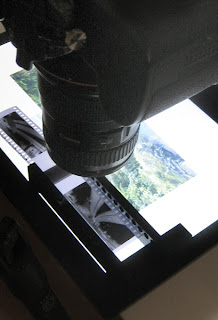- laptop // set the background color on white
- some LEGO stones
- DSLR
- Macro lens
- tripod

How to
- as amble some LEGO Stones together like the photo.
- Bring your film in your LEGO holder.
- set your laptop background color with.
- Set your laptop screen horizontal on a table.
- Adjust your DSLR cam parallel to the film and laptop screen.
- Tate photos from the film. Use manual mode. If your photos smaller than the hole film take photos from each part of the negative and stitch it in a graphic software on your computer together.
Finish your photo from the analog film in Photoshop
invert black&withe film:
- Image>adjustment>invert.
Invert color film:
- Image>adjustment>invert.
- Image >adjustment > levels (auto levels)
the second step is important, than your withe point from the film is a kind of orange. Your color will be wrong with out the second step!!
Here a samples photo how I digitalis with this technique. I took 12 photos from the negative with a 5dmarkII (21mpixel), and I get around 170mpixel digital photo...














